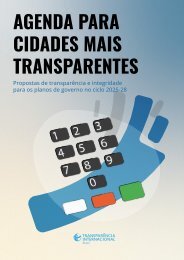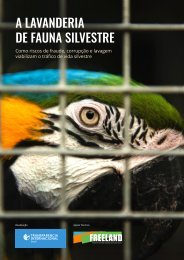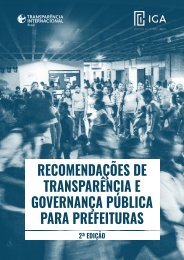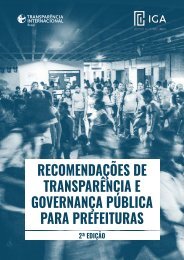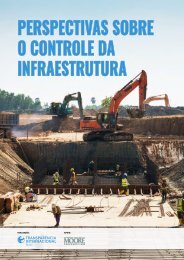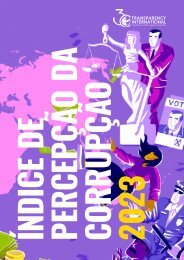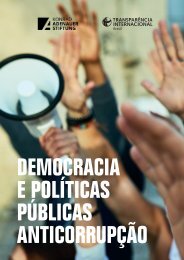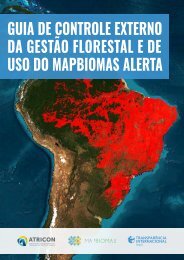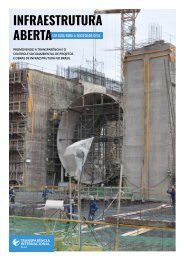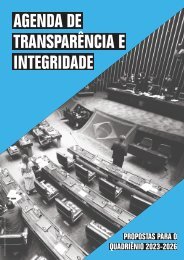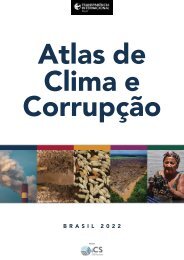The Wildlife Laundromat
Create successful ePaper yourself
Turn your PDF publications into a flip-book with our unique Google optimized e-Paper software.
THE WILDLIFE<br />
LAUNDROMAT<br />
How fraud, corruption and laundering<br />
drive wildlife trafficking
THE WILDLIFE<br />
LAUNDROMAT<br />
How fraud, corruption and laundering<br />
drive wildlife trafficking
Except where otherwise noted, this work is published under a free-use license. You may copy, adapt,<br />
and redistribute the content presented below, provided that you give appropriate credit to its authors.<br />
www.transparenciainternacional.org.br<br />
COORDINATION: Renato Morgado<br />
AUTHORS: Joachim S. Stassart, Dário Cardoso Jr.<br />
REVIEWERS: Juliana Machado Ferreira, Adhim Santiago Jr., Olivia Ainbinder, Renato Morgado,<br />
Flávia M. de A. Collaço, Guilherme France, and Amanda Faria Lima<br />
DESIGNER: Guto Rodrigues<br />
COVER: Niklas Garnholz/unsplash<br />
THE WILDLIFE LAUNDROMAT:<br />
how risks of fraud, corruption, and laundering enable wildlife trafficking<br />
May/2024<br />
This report is part of the project "Countering <strong>Wildlife</strong> Trafficking in Central and South<br />
America," coordinated by Freeland with the support of the United States Bureau of<br />
International Narcotics and Law Enforcement Affairs (INL) and in partnership with<br />
Transparency International Brazil, WWF Brazil, and IFAW. Aiming to enhance the<br />
effectiveness of combating wildlife trafficking at the regional scale, the project seeks<br />
to increase the detection and ban of these illicit activities, reinforce investigative<br />
and international cooperation capacities, improve criminal prosecution and ruling<br />
capabilities, and strengthen transparency and efforts to combat related corruption<br />
and laundering.<br />
ACKNOWLEDGMENTS: We thank all the experts who contributed to the development<br />
of this report through interviews, reviews, and other forms of support.<br />
A full Portuguese version of this report is available at:<br />
https://transparenciainternacional.org.br/publicacoes/a-lavanderia-de-fauna-silvestre
TRANSPARENCY INTERNATIONAL is a global movement present in over 100 countries<br />
with one purpose: to build a world in which governments, businesses, and people's<br />
daily lives are free from corruption. In Brazil, we work to produce specialized knowledge,<br />
mobilize local anti-corruption groups, and raise awareness and commitment<br />
in the public and private sectors to transparency and integrity practices, among<br />
other activities.<br />
Freeland is an international organization that helps protect vulnerable people and<br />
wildlife from organized crime and corruption, while revitalizing ecosystems and<br />
communities for a safer world. Freeland's vision is a world free of wildlife trafficking<br />
and human slavery. Freeland-Brazil is headquartered in São Paulo and its regional<br />
mission is to conserve biodiversity by fighting the illegal trade in wildlife.<br />
<strong>The</strong> U.S. Department of State and its Bureau of International Narcotics and Law<br />
Enforcement Affairs (INL) work to keep Americans safe by countering crime, illegal<br />
drugs, and instability abroad. INL works to build capacity within partner country law<br />
enforcement agencies to prevent several types of crimes, including international<br />
wildlife trafficking.
Photo DejaVu Designs / freepik
FOREWORD<br />
This work was carried out within the scope of the<br />
“Expanding the Detection, Investigation and Prosecution<br />
of Transnational <strong>Wildlife</strong> Trafficking and Fostering<br />
Interagency Coordination” project, supported by the<br />
United States Bureau of International Narcotics and<br />
Law Enforcement Affairs (INL). <strong>The</strong> project is led by<br />
Freeland, with that partnership of Transparency International<br />
Brazil, WWF-Brazil and the International<br />
Fund for Animal Welfare (IFAW). It has four main<br />
objectives, namely:<br />
1. Increase the detection of transnational wildlife<br />
trafficking<br />
2. Strengthen investigative proceedings in cases of<br />
transnational wildlife trafficking<br />
3. Strengthen criminal proceedings relating to these<br />
cases<br />
4. Identify and counter money laundering and corruption<br />
practices related to this type of crime<br />
<strong>The</strong> project proposes a series of actions to fight<br />
wildlife trafficking activities in Brazil. <strong>The</strong>se actions<br />
seek to increase the detection of this type of crime<br />
and encourage the use of investigative tools to identify<br />
professional trafficking networks, to support solid<br />
criminal proceedings to dismantle such networks,<br />
and to close loopholes that allow corruption and<br />
money laundering associated with wildlife trafficking.<br />
<strong>The</strong> overall goal is to disrupt the illegal wildlife trade,<br />
strengthen the fight against this multifaceted crime,<br />
and challenge the perception that it is a crime with<br />
high margins and low risk.<br />
FOR A WORLD FREE OF WILDLIFE TRAFFICKING AND CORRUPTION<br />
Renato Morgado<br />
PROGRAM MANAGER<br />
Transparency International - Brazil<br />
Juliana Machado Ferreira<br />
EXECUTIVE DIRECTOR<br />
Freeland Brazil<br />
7
Foto de Flávio Jota de Paula
EXECUTIVE SUMMARY<br />
“Empty forests” was the term used to describe<br />
South American forests suffering from the overexploitation<br />
of their animals (REDFORD, 1992). Despite<br />
the ban on sport and commercial hunting in Brazil,<br />
the trade in wild animals, their parts, and products<br />
has continued in illegality, enabled by multiple acts<br />
of fraud, corruption and money laundering. In addition<br />
to the impact on animal welfare and biodiversity,<br />
which leads to the loss of ecosystem services, wildlife<br />
trafficking can have other serious consequences,<br />
like facilitating the emergence of new infectious<br />
diseases such as COVID-19 and the expansion of<br />
organized crime and illicit activities.<br />
At a global level, estimates of revenue from<br />
wildlife trafficking sum up to billions of dollars every<br />
year and lead to the death of millions of animals.<br />
Brazil's rich and unique biodiversity and the existence<br />
of both significant domestic and international<br />
demand for wildlife, make the country particularly<br />
vulnerable to trafficking. Although the potential<br />
profit of this illicit economy is high, efforts to counter<br />
wildlife trafficking are insufficient to curb and<br />
effectively disrupt it in this massive country.<br />
<strong>The</strong>se efforts are particularly ineffective when<br />
hindered by fraud, corruption and laundering practices.<br />
Large trafficking schemes adopt such practices<br />
not only to undermine law enforcement actions,<br />
but also to “launder” wildlife, that is, to conceal its<br />
illegal origin and sell it in purportedly legal markets.<br />
In this context, “consumers” of wild animals might<br />
think they are acquiring a legal specimen when, in<br />
reality, they are encouraging trafficking and corruption<br />
schemes.<br />
Although the fight against wildlife trade has<br />
gained momentum in the international arena, in<br />
Brazil these efforts have only just begun. <strong>The</strong> objective<br />
of this report is to clarify how fraud, corruption<br />
and laundering practices enable wildlife trafficking,<br />
and to propose recommendations to the relevant<br />
agencies and institutions.<br />
To this end, we conducted a literature review<br />
and interviews with experts to assess weaknesses<br />
and gaps in wildlife management control systems,<br />
as well as shortcomings in efforts to counter wildlife<br />
trafficking. We also analyzed 17 cases that exemplify<br />
risks of fraud, corruption and laundering, as<br />
summarized in Map 1.<br />
9
CASE STUDIES<br />
ANALYZED IN THE REPORT<br />
OPERATION POSEIDON<br />
2017<br />
Tapajós River Basin<br />
CASE 25 Laundering crime in the case<br />
of ornamental fish trafficking<br />
CASE NAJA<br />
CASE OF THE DART FROGS<br />
2017<br />
USA; East of Pará (PA)<br />
CASE 10 Dart frogs laundered<br />
through fraudulent CITES permits<br />
2020<br />
Distrito Federal (DF)<br />
CASE 20 Influence peddling and<br />
interference in police investigations<br />
against trafficking schemes.<br />
CASE 22 Trafficked animals<br />
laundered by an employee of a<br />
wildlife rehabilitation center<br />
PA<br />
CASE OF THE ZEBRA PLECO<br />
2017 – 2022<br />
Xingu River, Altamira (PA)<br />
CASE 14 Zebra Plecos smuggled<br />
through countries with<br />
weaker controls<br />
PARLIAMENTARY INQUIRY COMMISSION ON BIOPIRACY<br />
2006<br />
Federal District (DF); Goiânia (GO)<br />
CASE 7 Fraudulent entries in zoo records<br />
to disguise the illegal trade of animals.<br />
MT<br />
OPERATION SÃO FRANCISCO<br />
2010<br />
Curitiba Region (PR)<br />
CASE 6 Illegally sourced birds<br />
laundered through fraud in<br />
marking systems (leg bands)<br />
CASE 12 International trafficking of<br />
eggs and birds by air using mules<br />
CASE 20 Influence peddling for<br />
the dismissal of administrative<br />
sanctioning processes<br />
CASE "CRIADOURO FANTASMA"<br />
2010<br />
Santo Antônio da Patrulha (RS)<br />
CASE 5 False declaration of breeding<br />
facilities in control systems.<br />
RS<br />
PR<br />
OPERATION BIRD BOX<br />
2019<br />
Uruguaiana (RS)<br />
CASE 23 Money laundering in ilegal<br />
international wildlife trade<br />
10 THE WILDLIFE LAUNDROMAT
CASE OF THE MACAW EGGS<br />
OPERATION MODA VIP<br />
2015<br />
São José do Rio Preto,<br />
Barretos (SP); Poconé (MT)<br />
CASE 3 <strong>Wildlife</strong> products laundered<br />
through fraud in tagging systems<br />
in the reptile leather supply chain<br />
2010<br />
Europe<br />
CASE 16 Eggs from endangered<br />
Brazilian macaws laundered in<br />
European breeding facilities.<br />
CASE OF “BRAZIL’S LARGEST TRAFFICKER ”<br />
OPERATION KILLIFISH<br />
2019<br />
Belo Horizonte (MG)<br />
2017<br />
Patos (PB)<br />
CASE 24 Laundering schemes to evade<br />
sanctions against trafficking.<br />
CASE 13 Ornamental fish eggs<br />
trafficked through mailing services<br />
OPERATION BOITATÁ<br />
PB<br />
2014 – 2015<br />
Niterói (RJ)<br />
GO<br />
DF<br />
OPERAÇÃO LESHY<br />
2021<br />
Guarulhos (SP)<br />
CASE 1 <strong>Wildlife</strong> trafficking<br />
motivated by illegal international<br />
trade and biopiracy.<br />
CASE 21 Ineffectiveness of alternative<br />
means of resolving criminal cases to<br />
hold repeat traffickers accountable<br />
CASE 8 Zoo engaged in parallel<br />
trafficking operations of wild<br />
animals under its custody.<br />
CASE 15 Rare snake smuggled out<br />
of the country and laundered<br />
through a transit country<br />
CASE 26 International cooperation for<br />
the repatriation of trafficked animals.<br />
OPERATION OXÓSSI<br />
SP<br />
MG<br />
RJ<br />
OPERATION FIBRA<br />
2014<br />
Guarulhos, Campinas (SP)<br />
CASE 4 Bribery of environmental<br />
agency contractors to input false<br />
data into passerine control systems<br />
to launder illegally sourced birds<br />
2009<br />
Baixada Fluminense (RJ)<br />
CASE 19 Bribery and direct involvement<br />
of military police officers in<br />
wildlife trafficking schemes<br />
CASE OF THE GIRAFFAS<br />
2022<br />
Mangaratiba (RJ)<br />
OPERATION URUTAU<br />
2014<br />
São Paulo (SP)<br />
CASE 2 Illegaly sourced animals<br />
sold as pets laundered through<br />
fraud in tagging systems<br />
(microchips) and invoices<br />
CASE 9 Fraud in transport<br />
documentation of wildlife<br />
CASE 11 Misconduct in the issuance<br />
of import authorization for giraffes<br />
CASE 18 Retaliation against<br />
environmental agency officers<br />
investigating the irregular<br />
importation of giraffes<br />
11
Following a comprehensive analysis of legal and<br />
institutional frameworks aimed at combating wildlife<br />
trafficking, we identified risks of fraud and corruption<br />
in wildlife management systems for domestic<br />
and international transactions. We also identified<br />
shortcomings and risks of corruption in inspection,<br />
investigation, and accountability actions performed<br />
by environmental and law enforcement agencies.<br />
Finally, we examined how wildlife trafficking is facilitated<br />
by crimes of laundering.<br />
In total, 24 risks of fraud, corruption and laundering<br />
that enable wildlife trafficking were identified.<br />
Table 1 systematizes these risks and describes: (1)<br />
the types of risk involved; (2) the illicit practice itself;<br />
(3) the main actors involved; and (4) the primary objectives.<br />
Overall, these attempts of fraud, corruption,<br />
and laundering seek to undermine law enforcement<br />
efforts or give an appearance of legality to illegally<br />
sourced wildlife (a practice known as “laundering”).<br />
TABLE 1 Risks of fraud, corruption, and laundering linked to wildlife trafficking<br />
TYPE OF<br />
RISK<br />
PRACTICE MAIN ACTORS OBJECTIVE<br />
Fraud<br />
False statements and entries in<br />
control systems for authorized<br />
breeders (SisFauna, SisPass and<br />
GeFau).<br />
Breeders, veterinarians and<br />
technical managers.<br />
“Laundering” of illegally sourced<br />
animals by falsely declaring that<br />
a given specimen was bred in<br />
captivity or regularly acquired.<br />
Fraud<br />
Tampering, counterfeiting,<br />
defrauding, selling, buying,<br />
reusing and illegally<br />
manufacturing tagging/marking<br />
systems (leg bands, seals and<br />
microchips).<br />
Specialists in manufacturing/<br />
tampering with tagging/marking<br />
systems.<br />
Making the possession of illegally<br />
sourced wildlife seem legal.<br />
Fraud<br />
Registering front men and false<br />
addresses in wildlife management<br />
control systems.<br />
Breeders.<br />
Obstructing inspection in<br />
breeding sites involved in wildlife<br />
trafficking.<br />
Fraud<br />
False records of deaths, thefts and<br />
escapes in wildlife management<br />
control systems.<br />
Zoos, breeders, wildlife<br />
rehabilitation centers (CETAS) and<br />
similar institutions.<br />
Diverting animals that purportedly<br />
went missing from these<br />
organizations into trafficking or<br />
eliminating records of laundered<br />
animals to conceal irregularities.<br />
Fraud<br />
Forging invoices and other<br />
documents necessary to prove<br />
the regular acquisition of wild<br />
animals.<br />
<strong>Wildlife</strong> traffickers, breeding<br />
facilities and zoos, among others.<br />
Simulating the regular acquisition<br />
of wild animals from traffickers.<br />
Fraud<br />
Irregular sale of wild animals by<br />
unauthorized organizations or<br />
individuals.<br />
Amateur passerine breeders and<br />
zoos, among others<br />
Selling wild animals without the<br />
required permits.<br />
Fraud<br />
Forging transport documents<br />
(animal transportation permits/<br />
sanitary documentation).<br />
<strong>Wildlife</strong> traffickers and final<br />
“consumers”.<br />
Ensuring that the transportation<br />
of wild animals of illegal origin is<br />
not detected.<br />
Fraud<br />
Fraud in import and export<br />
licenses (false information about<br />
the number of specimens, origin,<br />
species, marking system etc.), or<br />
false or non-existent justification<br />
for obtaining such permits.<br />
Traffickers, breeders and zoos,<br />
among others.<br />
Giving an appearance of legality<br />
to the imports/exports of wild<br />
animals of illegal origin.<br />
12 THE WILDLIFE LAUNDROMAT
TYPE OF<br />
RISK<br />
PRACTICE MAIN ACTORS OBJECTIVE<br />
Fraud<br />
Fraud in wildlife management<br />
control systems in transit or<br />
destination countries.<br />
<strong>Wildlife</strong> traffickers.<br />
“Laundering” illegally sourced<br />
wildlife native to Brazil in transit<br />
or destination countries with poor<br />
control systems and regulations.<br />
Fraud<br />
Fraud in technical research on<br />
populations of wild species and<br />
the level of extinction threat.<br />
<strong>Wildlife</strong> traffickers, breeders and<br />
zoos, third-party technicians,<br />
among others.<br />
Loosening rules and permit<br />
requirements for breeding and/or<br />
capturing some species.<br />
Fraud<br />
False declarations about the real<br />
identity and address of traffickers<br />
who send wild animals to<br />
“consumers”.<br />
<strong>Wildlife</strong> traffickers.<br />
Obstructing the inspection of<br />
couriers and transportation<br />
companies.<br />
Collusion/<br />
bribery<br />
Inaction, neglecting investigations<br />
against wildlife trafficking.<br />
Law enforcement and/or<br />
environmental agents.<br />
Avoiding seizures and other<br />
sanctions related to crimes<br />
against wildlife.<br />
Collusion/<br />
bribery<br />
Leaking information about<br />
inspection actions.<br />
Law enforcement and/or<br />
environmental agents.<br />
Avoiding seizures and other<br />
sanctions related to crimes<br />
against wildlife.<br />
Collusion/<br />
abuse of<br />
office<br />
Direct involvement of public<br />
agents in wildlife trafficking<br />
schemes and misuse of their<br />
public office and/or resources.<br />
Law enforcement and/or<br />
environmental agents.<br />
Abusing one’s office and/or<br />
authority to ensure impunity for<br />
trafficking schemes.<br />
Collusion<br />
and/or<br />
bribery<br />
Entering or confirming false data<br />
in control systems (SisFauna,<br />
SisPass and GeFau).<br />
Agents from environmental<br />
agencies.<br />
Facilitating wildlife laundering<br />
schemes.<br />
Collusion<br />
and/or<br />
bribery<br />
Issuing irregular permits for<br />
transporting or keeping animals<br />
from wildlife rehabilitation<br />
centers..<br />
<strong>Wildlife</strong> rehabilitation centers<br />
agents.<br />
Supplying trafficking networks<br />
with animals coming from <strong>Wildlife</strong><br />
rehabilitation centers agents,<br />
facilitating wildlife laundering<br />
schemes.<br />
Collusion<br />
and/or<br />
bribery<br />
Issuing import/export licenses<br />
in clear violation of legal<br />
requirements.<br />
Agents from environmental<br />
agencies.<br />
Enabling the export or import of<br />
illegally sourced wildlife.<br />
Collusion<br />
and/or<br />
bribery<br />
Transporting wildlife of illegal<br />
origin.<br />
Carriers of people and goods,<br />
logistics companies.<br />
Enabling the transportation of<br />
wildlife of illegal origin to end<br />
customers.<br />
13
TYPE OF<br />
RISK<br />
PRACTICE MAIN ACTORS OBJECTIVE<br />
Collusion<br />
and/or<br />
bribery<br />
Bribing border inspection officers<br />
and/or customs agents (airports,<br />
ports and land borders).<br />
Brazil’s Federal Police, Ibama, and<br />
Customs officers.<br />
Enabling the exports or imports of<br />
illegally sourced wildlife.<br />
Abuse of<br />
office<br />
Using sanctions or retaliation<br />
against law enforcement agents<br />
who investigate wildlife trafficking.<br />
Prominent public agents,<br />
including high-ranking officers<br />
in environmental or law<br />
enforcement agencies.<br />
Hindering investigations against<br />
trafficking networks, intimidating<br />
law enforcement agents and<br />
protecting vested interests.<br />
Influence<br />
peddling/<br />
undue use<br />
of one’s<br />
political<br />
influence<br />
Exercising pressure on<br />
environmental or law<br />
enforcement agents to close<br />
investigations or administrative,<br />
civil, or criminal proceedings<br />
against traffickers.<br />
Prominent public agents,<br />
including high-ranking officers<br />
in environmental or law<br />
enforcement bodies.<br />
Ensuring the impunity of wildlife<br />
criminal networks.<br />
Undue<br />
influence<br />
Influence the design of norms<br />
and regulations to make breeding<br />
and/or (international) trade of<br />
wildlife in captivity more flexible<br />
or to loosen control systems.<br />
Traffickers and legal or<br />
illegal breeders with political<br />
connections.<br />
Loosening regulations on wildlife<br />
captive breeding, legalizing<br />
forms of wildlife trafficking and<br />
hampering efforts to fight wildlife<br />
laundering.<br />
Laundering<br />
Concealing the illegal origin of<br />
wildlife through fraud and other<br />
corrupt practices.<br />
Members of wildlife trafficking<br />
networks.<br />
Giving an appearance of legality to<br />
illegally sourced wildlife.<br />
Laundering<br />
Concealing the illegal origin of<br />
proceeds and goods from wildlife<br />
trafficking activities.<br />
Members of wildlife trafficking<br />
networks.<br />
Making it difficult to identify<br />
and hold wildlife traffickers<br />
accountable.<br />
Fraud, corruption and laundering involve multiple private and public agents, ranging from breeders, zoo<br />
managers, counterfeiting experts, carriers and front persons to public agents, especially law enforcement<br />
and environmental agents. Importantly, these risks can occur at different stages of the wildlife trafficking<br />
chain, as shown in Figure 1.<br />
14 THE WILDLIFE LAUNDROMAT
FIGURE 1 risks of fraud and corruption throughout the wildlife trafficking chain<br />
POACHING<br />
Inaction on the part of<br />
law enforcement agents<br />
ACQUIRING WILDLIFE<br />
Fraud in zoo records<br />
Collusion with specialists<br />
Fraud in rehabilitation centers<br />
transport/custody permits<br />
Bribery/collusion with<br />
rehabilitation centers staff<br />
DOCUMENTATION<br />
Fraud in marking/tagging systems<br />
Fraud in control systems for captive wildlife<br />
Bribery/collusion with environmental agency officers<br />
TRANSPORT<br />
Fraud in transport and sanitary documentation<br />
Bribery/collusion with police officers<br />
Collusion with transport and logistics companies<br />
WILDLIFE LAUNDERING<br />
EXPORTS/IMPORTS<br />
Fraud in import/export permits (including CITES)<br />
Fraud in import/export statements<br />
Collusion/bribery/misconduct in issuing and controlling import/export permits<br />
Bribery of customs officers<br />
SALES<br />
Fraudulent invoicing<br />
END CONSUMER/TRAFFICKER<br />
Using front persons<br />
LAUNDERING ASSETS<br />
AND PROCEEDS<br />
Corruption<br />
Fraud<br />
15
<strong>The</strong> first stage in the wildlife trafficking chain is<br />
sourcing. Our research identified two potential origins.<br />
On the one hand, poaching is an important source<br />
of wild specimens. In this case, to avoid sanctions,<br />
poachers may collude or pay bribes to ensure that<br />
law enforcement and environmental agents turn a<br />
blind eye to any irregularities.<br />
<strong>The</strong> second source comprises institutions that<br />
receive animals from seizures and rescues, or that<br />
have facilities to acquire wild animals (including exotic<br />
species) on a regular basis, like zoos or wildlife<br />
rehabilitation centers (CETAS/CRAS). In these cases,<br />
to conceal the illegal disappearance of animals, employees<br />
can falsify records to account for the missing<br />
animals, possibly with the help of specialists like veterinarians,<br />
who can issue false death certificates for<br />
these animals, for example. Alternatively, transport<br />
or custody permits granted by these institutions may<br />
be issued irregularly to conceal the illegal possession<br />
of specimens by traffickers.<br />
Subsequently, traffickers may attempt to launder<br />
the specimens by tagging them with fraudulent<br />
microchips or leg bands, or making false entries into<br />
official control systems to artificially comply with<br />
administrative and legal obligations for the possession<br />
of wild animals. Corrupt environmental officers<br />
can help traffickers and use their access to internal<br />
systems to facilitate frauds or turn a blind eye to<br />
irregularities. Transport and sanitary documentation<br />
can also be forged to conceal the movement of<br />
specimens along the trafficking chain.<br />
When it comes to international trafficking schemes,<br />
fraud and corruption can facilitate the illegal<br />
transportation of specimens across borders. Import<br />
and export permits are mandatory for the international<br />
transportation of wildlife, but they can be defrauded<br />
with the possible help of environmental<br />
agents. Even without a permit, traffickers can move<br />
these animals by declaring them as goods that do<br />
not require sanitary or environmental control, potentially<br />
with the help of transportation companies<br />
and carriers. Traffickers can also try to bribe customs,<br />
environmental and law enforcement agents who<br />
control the entry and exit of people and goods at<br />
airports, ports and land border crossings to facilitate<br />
the international transit of these animals.<br />
Frauds that precede the sale to end consumers<br />
serve to conceal irregular transactions and can also<br />
be consolidated by false invoicing. In the case of<br />
professional traffickers, assets purchased with illicit<br />
money can be registered in the name of front persons<br />
to try to conceal their illicit origin. For this purpose,<br />
classic laundering tactics, like the use of shell companies<br />
or moving small amounts of cash at a time,<br />
can also be used. Finally, the successive fraud and<br />
corruption practices that seek to conceal the illegal<br />
origin of trafficked animals can be considered to form<br />
wildlife laundering schemes.<br />
Based on our assessment of fraud, corruption<br />
and laundering risks, as well as the analysis of control<br />
systems and efforts to combat illegal wildlife<br />
trade, we issued recommendations to strengthen<br />
the fight against wildlife trafficking with an anti-corruption<br />
approach. <strong>The</strong>se recommendations seek to<br />
prevent and detect identified fraud, corruption and<br />
laundering risks and hold perpetrators accountable.<br />
<strong>The</strong> recommendations are divided into five tracks:<br />
1. Strengthen mechanisms to prevent corruption<br />
in environmental and law enforcement<br />
agencies<br />
• Design and enforce integrity plans.<br />
• Implement technical criteria for political appointments<br />
to high-level positions.<br />
• Conduct internal and external audits focused on<br />
wildlife management.<br />
• Ensure balanced and transparent representation<br />
of all stakeholders in the design of wildlife-related<br />
regulations.<br />
2. Improve fraud prevention and detection in<br />
wildlife management and trade control systems<br />
• Standardize wildlife tagging/marking systems.<br />
• Conduct in-person inspections to identify fraud in<br />
declarations of entry and exit of birds in passerine<br />
breeding grounds.<br />
• Consider banning the breeding of birds by amateur<br />
breeders to prevent fraud in birth declarations.<br />
• Consider banning the breeding of certain species<br />
whenever laundering risks cannot be mitigated.<br />
• Monitor the use of CITES permits for native Brazilian<br />
species sold in other countries.<br />
• Continue to invest in forensics to identify wildlife<br />
laundering schemes.<br />
16 THE WILDLIFE LAUNDROMAT
3. Mobilize anti-laundering instruments to counter<br />
wildlife trafficking<br />
• Investigate and prosecute laundering crime in<br />
wildlife trafficking schemes.<br />
• Publish guidelines and identify red flags to support<br />
the sectors required to report suspicious<br />
operations.<br />
• Regulate laundering prevention requirements for<br />
the sectors involved in wildlife trade.<br />
• Encourage the production of financial intelligence<br />
reports related to wildlife trafficking cases.<br />
• Foster international cooperation to disrupt illicit<br />
financial flows linked to wildlife trafficking.<br />
4. Untap the potential of digital transformation<br />
and transparency<br />
• Standardize data about seizures to integrate them<br />
into a single database and make them available<br />
in an open format.<br />
• Make data about administrative environmental<br />
sanctions available in an open format.<br />
• Integrate data from different wildlife control systems<br />
and make them available in an open format.<br />
• Evaluate and enhance the transparency of environmental<br />
agencies and systems related to wildlife<br />
management and trade.<br />
• Integrate environmental databases with anti-money<br />
laundering databases.<br />
5. Enforce stricter criminal and administrative<br />
sanctions for traffickers<br />
• Provide training to law pratictioners to effectively<br />
investigate, prosecute, and adjudicate crimes related<br />
to wildlife trafficking, including corruption,<br />
money laundering, and the different forms of<br />
fraud.<br />
• Avoid limiting proceedings to police reports of<br />
minor offense, plea bargains or non-criminal prosecution<br />
agreements for large wildlife trafficking<br />
schemes.<br />
• Avoid leaving seized wild animals under the custody<br />
of the offender.<br />
• Identify and eliminate bottlenecks that prevent<br />
the proper enforcement of environmental administrative<br />
sanctions.<br />
• Audit and make recommendations to improve the<br />
effectiveness of administrative enforcement and<br />
sanctioning processes in environmental agencies.<br />
17
transparencia-internacional-brasil<br />
@transparenciainternacionalbr<br />
ti_interbr




